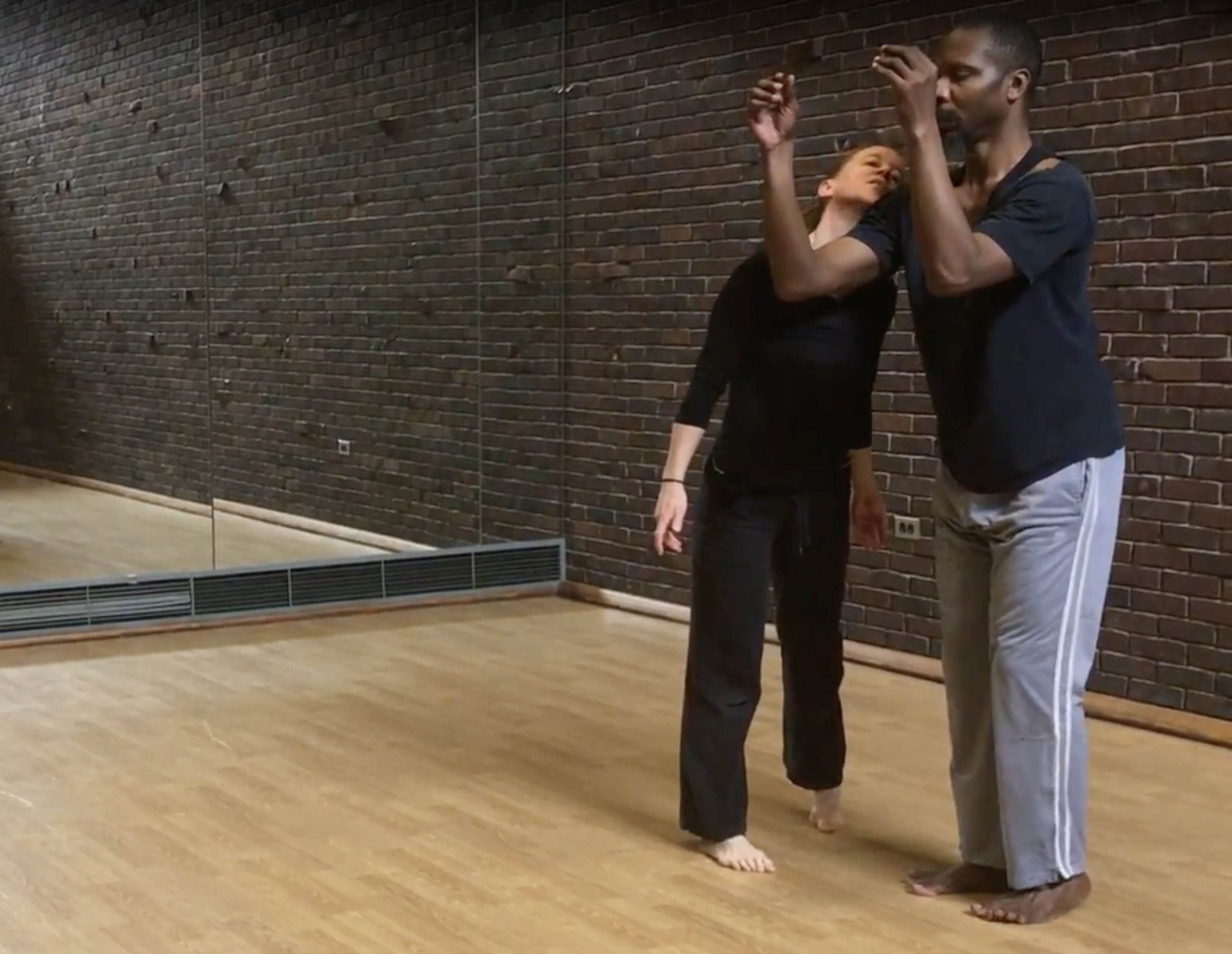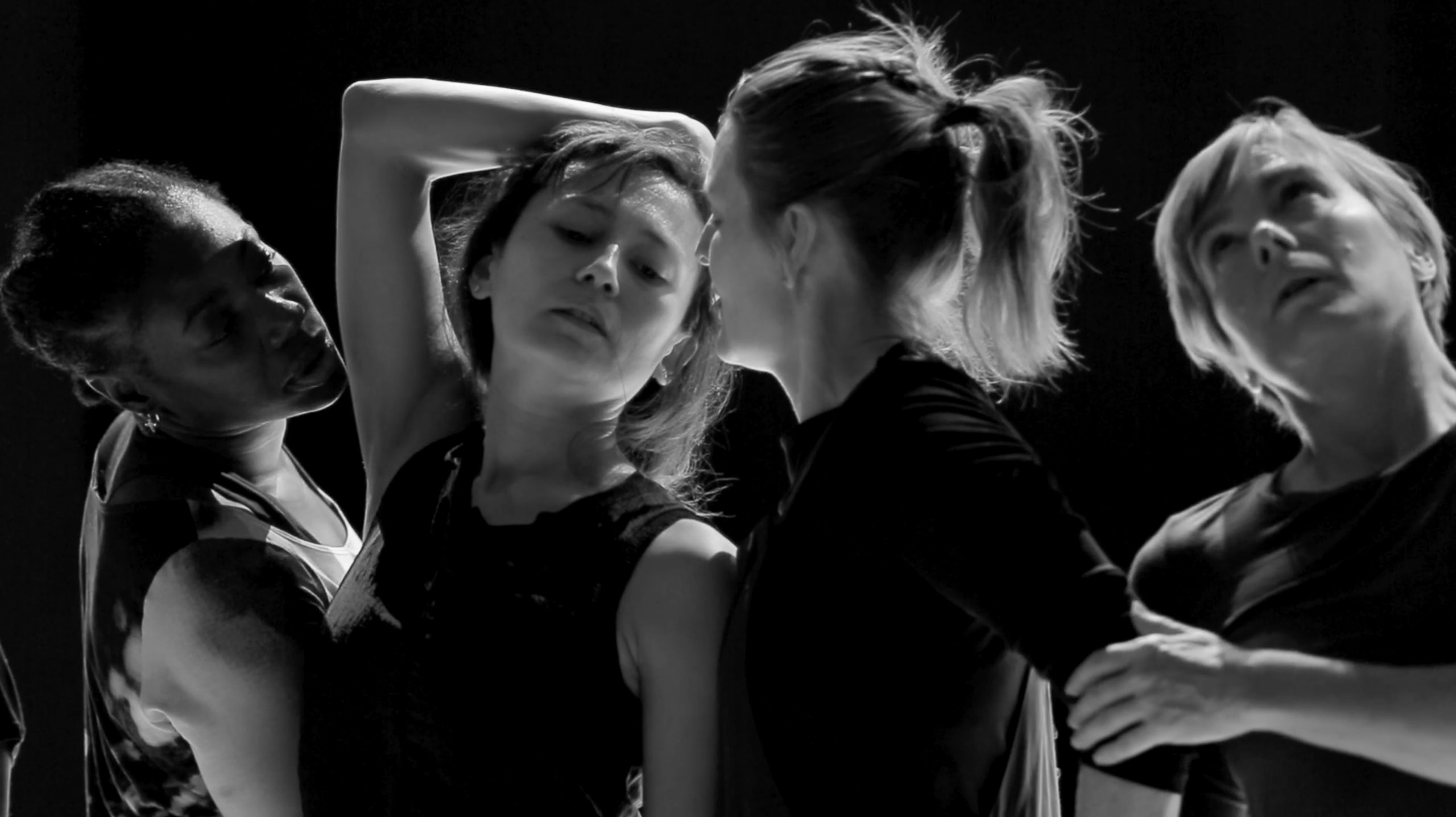
The circumstance of who we are together—disparate artists and complicated people working to make the dance we have started—is a dynamic presence in the room. Everyone is in their 40th year or older; three are parents of school-age children; ethnically we are four African Americans, three of European descent, one of mixed heritage. We are gay and straight. And as it was for many in our various communities, the year had been a political challenge. The sense that the time is now is an aesthetic strategy as well as a personal and political one. The convergence of these long-term professional artists, from different parts of the country and each sustaining a productive life in the dance field, carries with it a boldness of presence. We are new to each other but deep in the world.
When we started The Making Room the year before all we had in mind was to enter it and see what happened. The actual first steps in a creative process hold the weight and attention of one person in resonant time with another; nothing is abstract. We contain multitudes. We also are in active response to our times, particularly as the contextual traces collect around the work. By this point in time, almost a year after we began, we are mining the mix of pungent physicalities in the room, noting syntax as it was catalyzed by the politics of social cultures. Toni Morrison, Charlie Rose, David Foster Wallace, immigration, vogueing, The Read are all in the room with us.
By the end of the January 2017 residency at Smith we had reached a promising point. Ideas were respectfully challenged as dancing took on our complicated times. Syntax as a strategy, a way to pay attention, was delicious to look for, talk about, read about, argue about, and then it was delicious to dance. Improvisations became scores. Scores were re-entered and bloomed into one-of-a-kind dances. Forms emerged. Duets became channels of attentive behavior. The seasoned maturity and depth in the room was humbling, as was the dancers’ willingness to enter the game and make something new.
The Neilson Lectures, part of the terms of my visiting professorship at Smith, began after the January residency. The series would include performances of sections-in-progress by Angie and Bronwen, and offer a means to dig deeper into the dancing that was emerging. Information from the Kahn colloquium and related lectures simmered in my thinking in and out of the studio. The resource of available time shaped the schedule for various pairings through the spring. Angie and I were shaping a separate duet, to be performed in July at the 35th anniversary gala at the Bates Dance Festival honoring departing director Laura Faure. The convergence of the spring rehearsals, the Neilson lectures, the Kahn colloquium and related symposia, and upcoming performance was serendipitously productive.
What follows are transcripts and notes from our rehearsals tracking the semester’s progress. We are prodding the choreography into being, catching clues from movement and trains of thought like a kinetic game of Jeopardy. There is no there anywhere, but the signage is enticing.
Winter and Spring Ensembles
February 2017: Bebe and Angie Talks
Bebe: Something about syntax and flow also has to do with the delivery of information, or the delivery (to an audience) of a way to receive an experience. I think we’re deeply in the habit of working with that foreknowledge—so much so that we don’t even reference it sometimes. But that foreknowledge is syntactically important, since that’s the reference that we have about these shapes of information: how do they line up, how do they sing, or tell.
Angie: The design problem to solve for this first [lecture]: we’re coming out of this very immersed accumulative process, building information and experiences that are changing the meanings of these words. We’re having the experiential backstory. The audience will not have any of that. The problem to solve at the very beginning: what is the frame that brings them in, makes them comfortable and not disoriented, and ideally supports us to share the real thing we’ve been doing? What’s the frame, the Big Question, the statement from Bebe that sets this up? The verbal statement, question…
Bebe: Syntax and Flow: it’s not like, “this is a piece about syntax and flow.” It’s an orientation of mind, a way to perceive and question a set of experiences. How that may be leading to a finished piece is almost beside the point. I don’t want to say that we’re making this piece [about syntax]. But in making a piece, this piece, syntax has emerged.
Angie: A choreographic and, in that way, collaborative expression. A broader… not what we always do but a core question that Bebe has asked in different ways over her life of making dances.
Bebe: There is a question to keep asking, one leads to the next. With syntax and flow—our experience, looking at it in terms of their experience, all of our experiences—I think a beginning set-up is somewhere in the middle of all that. A good reminder: getting them on the page about this piece, or getting us all on the same page of looking at experience.
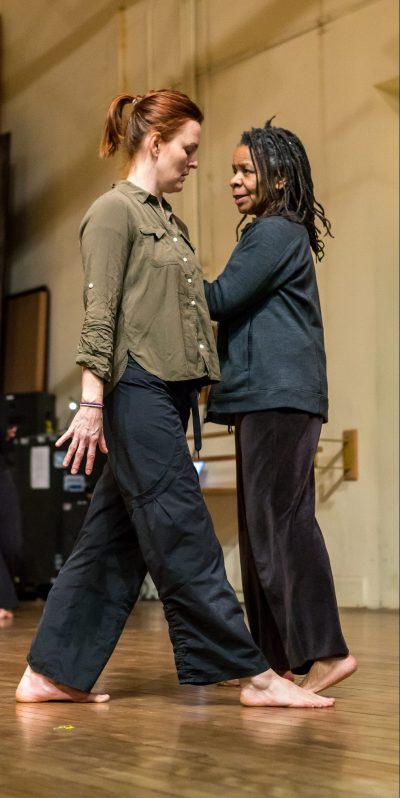
Angie and I often remarked on how we didn’t know “what it means” but we knew “it” carried meaning. We knew that the elements of meaning were present. Tricky, but I believe in it. I think it is basic to what we do in this field. It is an arrangement through time and dynamic, a delivery of something that’s often unnameable, but we receive it, it enters us, we “understand” it in a particular way. Faith is not the exact word, but faith in the body speaking to and with, in time and event, is understood. The poetics—of event, of moment, of relationship—is what it comes down to; the poetics being, if not information, then a felt shorthand of sensibility.
February 2017: What We Did in Two Days
Michelle, Darrell and I meet on a Thursday afternoon in Brooklyn, NY, in a former ballroom-turned-studio managed by the Alliance of Resident Theatres (A.R.T./New York). Michelle’s interest in working with BMC was sparked by a duet improvisation by Darrell and Angie she’d seen during the Movement Research Gala in 2015; she said she wanted to understand partnering the way they understood it. On this day Michelle and Darrell are immediately electric, tuned into the delight of matching a partner’s curiosity with your own, full strength. I’m the DJ and somewhat directorial, offering adjustments in approach to extend some spark that I can see from the outside. They work in silence, then I play a range of tunes and finally land on Donny Hathaway’s “I Love You More Than You’ll Ever Know.” Darrell speaks of R&B timing, the way a slow dance phrases itself even if you’re moving quickly. He is a partner in tune with risk; Michelle seems to find the most tenuous of physical connections and still remain in touch, literally, in sync, in rhythm. I step in now and again but mostly watch them. This is the first rehearsal of what would become their Donny Duet, and, due to other circumstances, would then become Michelle’s Donny Solo. Angie joins the group two days later. There is quite a bit of history between the three to refer to: Michelle and Angie’s duet from the previous residency; Angie and Darrell’s ongoing partnered explorations that began in 2001 while working on Verge. The day feels mostly like a promise of potential developments that might affect duets and/or trios between them. All good work, all of it useful.
Michelle’s notes from the two days are here.
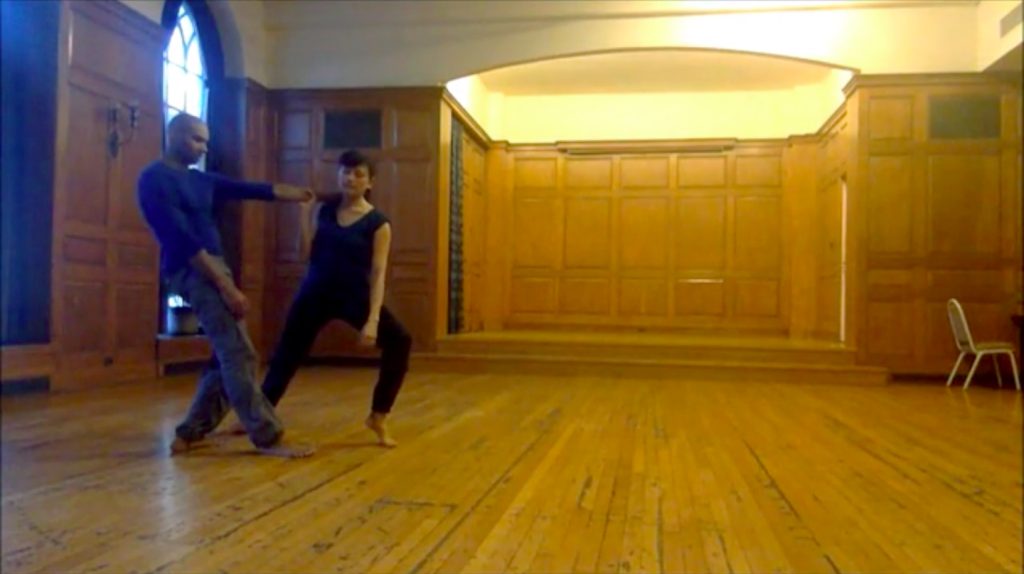
March 2017: Range Rover, Bronwen and the Librarian
Christal, Sarah, Bronwen, Tré and I gather at Smith College. One idea is to form a quartet based on the Nelly material that surfaced in January, when Nelly’s “Country Grammar” became the driver in the room. “Country Grammar” is old-school hip-hop; it has a great back beat with lyrics that reference street—I’m going down down baby your street in a Range Rover – language – my grammar be’s ebonics – and culture — daps and hugs, mean mugs and shoulder shrugs. The lyrics are not kind to women; they are aimed elsewhere. We set the dance material, driven by vocabulary references and rhythms that carry a street feel of their own, personal histories of dancing in other times and places. The women improvise to craft short solos. We try their trio as foreground/background to Tré’s own solo. The combination doesn’t feel right to me, so we separate the two dances, coming up with a Nelly trio for the women. In the meantime, Tré spins out his own Nelly solo. Over time it recirculates as a reference to other Tré bits that emerge much later.
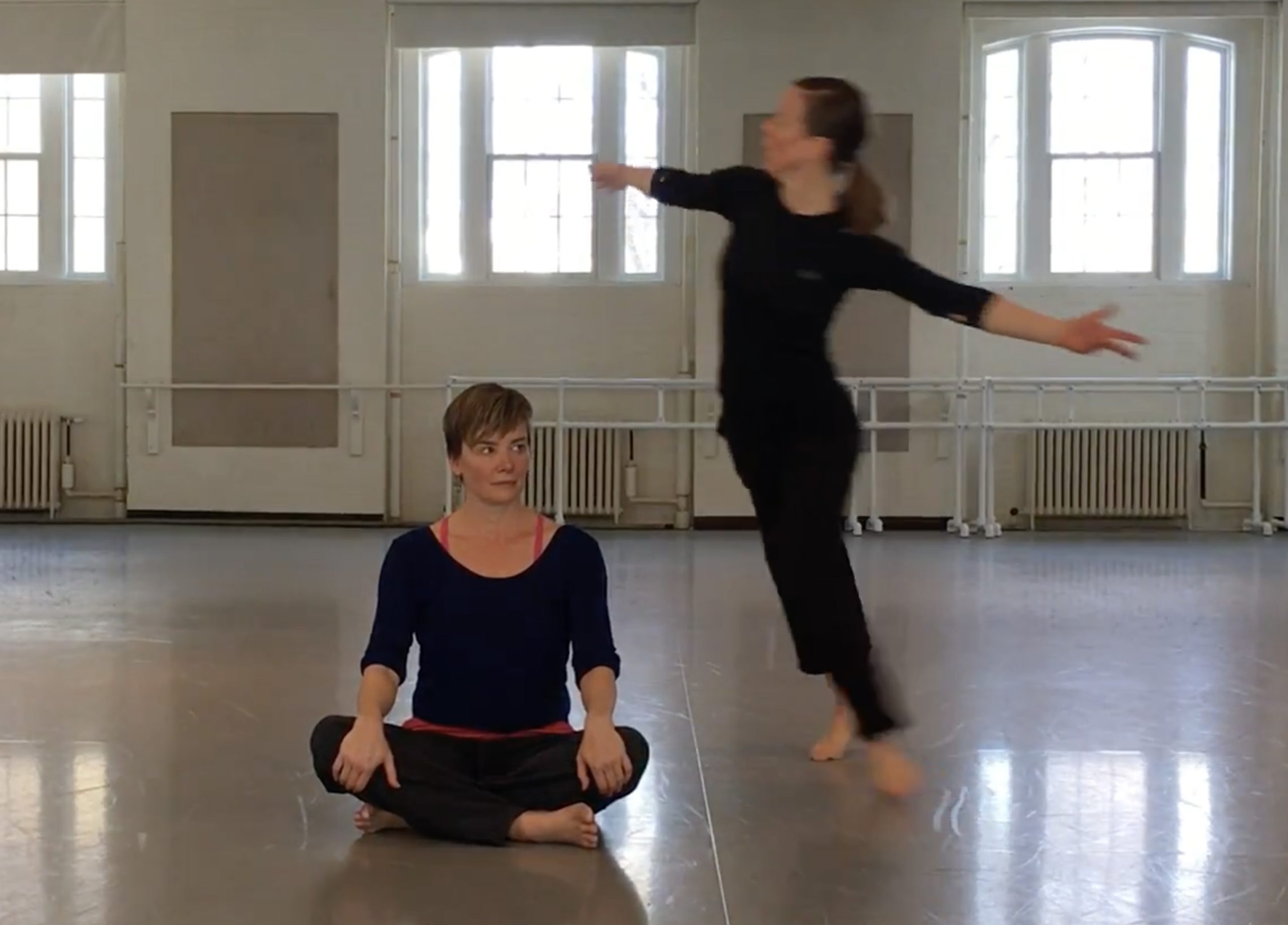
Bronwen has been building a solo over the last month. She and I have found a way of working together: she improvises short bits, I make suggestions and coach her along the lines of timing and dynamic junctures. She works toward setting it phrase by phrase, and we both note how satisfying and old-school this way of working feels. We both recall our own rehearsal histories from 20 years before. I remember days spent working and reworking a phrase of dancing, no other reference point beyond the physical, abstract play of weight in time. I remember dancer Earnie Stevenson in the 1990s, gently chiding me, missing that particular rigor of abstraction as our work shifted to a different kind of theatrical form.
For the heck of it I ask Sarah to sit downstage of Bronwen, remaining in place. She’s agreeable, she seems private, contained and slightly worried. This will lead to Sarah the Librarian, more a way of being present rather than an actual character, that Sarah will continue to thread through the piece. What she is thinking and imagining is a mystery to me but the juncture of the timing and dynamics of her mental wanderings, as with Bronwen’s, is worth following. They are both great at this. In time Bronwen’s solo with Sarah the Librarian will separate into their own places in the work.
April 2017: Hero and Attendant, Bronwen and Tré
A note for reference: Bronwen had joined Angie and me in the Smith College crew house in early 2016. I had seen Bronwen dance in works of some of my favorite choreographers in the 1990s; it was a pleasure to return to watching her move, even more to see how she might begin a project. Over a day or so we were “exploring,” musing kinetically over what we might do together, pre-Making Room. A year later we were back at Smith. In January we had found a score we called Hero and Attendant based on a purposeful kind of support. One dancer blooms fully into their Hero (release! Welling up!) while another Attends. Now, Bronwen and Angie finalize the score, repurposing Bronwen’s set solo from March to be partnered by Angie’s improvised response—Hero and Attendant. I watch the two women continually keystone their efforts together, their fluency generating the kind of attention that must make us all better people. The ephemeral nature of support—“I gotcha, go ahead”—and the way one moment bleeds into the next and the next, speaks to me of living life.

During the two jam-packed weeks of the Smith residency in January, Bronwen and Tré developed a tuning toward each other, a readable frame of working together. Over a long weekend we continue to develop their duet-ness based on their growing understanding of each other’s style; they like dancing together.
They speak quietly about this or that resolution to a sequence they’ve found. We work on short connective tissues of partnering: improvise-repeat-then-set. I’m on the lookout for where to steer them through space, eventually settling on a workable form that fits. We work quickly and carefully; we don’t have a lot of time. I watch for how they work more so than what they work on, seeing what needs repeating, where they gravitate, what can be maneuvered elsewhere. There isn’t a plan for the sequence we’re developing beyond working to find a reference point between them that could be returned to in July, during our production residency at the Wexner Center for the Arts.
